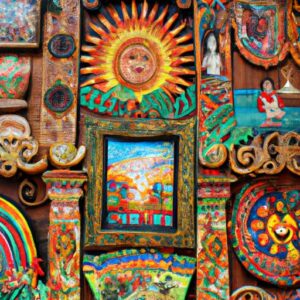When it comes to exploring artistic endeavors, the distinction between visual arts and drawing is often a point of confusion. Are they the same thing, or are there significant differences between the two? In this article, we will delve into the realm of visual arts and drawing, unraveling their unique aspects and shedding light on how they intertwine. So, let’s embark on this creative journey together and discover the essence of visual arts and drawing.
A. Definition of Visual Arts and Drawing
To start our exploration, it’s essential to have a clear understanding of what visual arts and drawing entail. Visual arts encompass a wide range of creative expressions, such as painting, sculpture, photography, and more. It is a broad term that encompasses various mediums and forms through which artists convey their thoughts, ideas, and emotions.
On the other hand, drawing, though a part of visual arts, focuses specifically on the act of creating images through lines and marks on a surface. Drawing serves as a foundational skill for many artists, allowing them to bring their ideas to life and communicate visually.
B. Brief Overview of the Relationship between Visual Arts and Drawing
Visual arts and drawing share a symbiotic relationship. Drawing is a fundamental aspect of visual arts, serving as a precursor to more complex artistic endeavors. It serves as a means of exploration, planning, and experimentation, acting as a bridge between an artist’s imagination and the final artwork. Drawing can be seen as the backbone of visual arts, providing the necessary skills and techniques for artists to express themselves.
C. Importance of Understanding the Distinction between Visual Arts and Drawing
While visual arts and drawing are interconnected, it is crucial to recognize their distinctions. Understanding the differences between the two allows us to appreciate the diversity within the artistic realm fully. By discerning the unique qualities and objectives of visual arts and drawing, we can better comprehend the intentions and techniques employed by artists.
Moreover, comprehending the distinction between visual arts and drawing assists aspiring artists in choosing their preferred path and exploring their creative potential. It enables individuals to identify their strengths, passions, and areas of interest, ultimately shaping their artistic journey.
As we move forward, we will delve deeper into the realms of visual arts and drawing, unraveling their intricacies and uncovering the similarities and differences that make them both captivating and distinct. So, let’s continue our exploration and discover the wonders that await us in the realm of artistic expression.
Understanding Visual Arts
A. Definition and Scope of Visual Arts
Visual arts encompass a vast realm of artistic expressions that appeal to our visual senses. It encompasses a wide range of mediums, techniques, and styles, allowing artists to convey their ideas and emotions in a visual format. From traditional forms like painting and sculpture to contemporary art forms like digital art and installations, visual arts encapsulate the diverse and ever-evolving world of artistic creation.
B. Various Forms and Mediums of Visual Arts
Visual arts encompass a multitude of forms and mediums, each with its unique characteristics and methods of expression. Painting, for instance, involves using pigments and brushes to create images on surfaces like canvas or paper. Sculpture, on the other hand, involves shaping and molding materials like clay, stone, or metal to create three-dimensional artworks.
Photography, printmaking, ceramics, and mixed media are just a few examples of the extensive range of visual art forms that exist. Each medium offers artists a distinct set of tools and techniques to bring their visions to life, allowing for endless possibilities of creative exploration.
C. Role of Creativity and Imagination in Visual Arts
At the heart of visual arts lies the essence of creativity and imagination. Visual artists harness their creative energies and visions to craft compelling and thought-provoking artworks. They draw inspiration from the world around them, their personal experiences, and their inner thoughts and emotions.
Creativity in visual arts involves thinking outside the box, pushing boundaries, and experimenting with new ideas and techniques. It is through their imaginative prowess that artists breathe life into their creations, evoking emotions, sparking conversations, and challenging societal norms.
Artists utilize their creativity and imagination to explore various themes, express their perspectives, and engage viewers in a profound and meaningful way. Visual arts provide a platform for artists to communicate and connect with audiences on a visual and emotional level, transcending language barriers and cultural differences.
Understanding the essence and significance of visual arts sets the stage for appreciating the diverse and captivating world of artistic expression. As we continue our exploration, we will now delve into the realm of drawing, unraveling its unique characteristics and shedding light on its relationship with visual arts.
Understanding Drawing
A. Definition and Significance of Drawing
Drawing is more than just putting pen to paper or pencil to canvas. It is a powerful form of artistic expression that allows individuals to visually communicate their thoughts, emotions, and observations. Defined as the act of creating images through lines and marks, drawing holds great significance in the artistic world.
Drawing serves as a foundation for many artists, providing them with a means to explore their ideas, develop their skills, and experiment with different concepts. It allows artists to capture the essence of their subject matter, whether it be a still life, portrait, or abstract representation. Through drawing, artists can convey depth, form, and texture, breathing life into their creations.
B. Different Techniques and Styles Used in Drawing
Drawing encompasses a vast array of techniques and styles, each offering a unique approach to artistic expression. From the precision and realism of classical drawing to the fluidity and spontaneity of sketching, artists have a multitude of options at their disposal.
Techniques such as crosshatching, stippling, and shading allow artists to manipulate light and shadow, creating depth and dimension in their drawings. Meanwhile, styles like abstract, impressionistic, and hyperrealism offer diverse avenues for artists to explore their creativity and convey their personal vision.
C. Relationship between Drawing and Visual Arts
Drawing plays a vital role in the broader realm of visual arts. It serves as a common thread that connects various artistic disciplines, acting as a foundation upon which artists build their skills and explore their creative potential. Many visual artists begin their artistic journey by honing their drawing abilities before branching out into other mediums.
While drawing is an art form in itself, it also serves as a tool for artists across different visual art disciplines. Painters often sketch preliminary drawings to plan their compositions, sculptors use drawings to visualize their three-dimensional creations, and photographers utilize drawing techniques to enhance their understanding of composition and framing.
Understanding the relationship between drawing and visual arts allows us to appreciate the interconnectedness of different artistic practices. It highlights the importance of drawing as a fundamental skill that transcends individual art forms, fostering a deeper understanding and appreciation for the broader world of visual arts.
As we continue to explore the distinctions and connections between visual arts and drawing, we will uncover the unique aspects of each and gain a more comprehensive understanding of their significance in the artistic landscape. So, let’s delve deeper into the intricacies of these creative realms and continue our artistic journey together.
Differentiating Visual Arts and Drawing
In order to truly appreciate the realms of visual arts and drawing, it is essential to understand the ways in which they differ. While they share common ground, they also possess distinct objectives and characteristics. Let’s delve deeper into these differences and explore the unique aspects of visual arts and drawing.
A. Comparison of Objectives in Visual Arts and Drawing
Visual arts and drawing have different objectives that guide the artist’s creative process. Visual arts aim to evoke emotions, provoke thoughts, and convey messages through various mediums and forms. Artists in this realm often strive to create visually captivating and thought-provoking artworks that engage the viewers on multiple levels. On the other hand, drawing often serves as a means of observation, exploration, and skill-building. It is a tool through which artists develop their techniques and ideas, laying the foundation for more complex artistic endeavors.
B. Distinguishing Characteristics of Visual Arts and Drawing
While visual arts and drawing are interconnected, they possess distinguishing characteristics that set them apart. Visual arts encompass a broader range of mediums and forms, allowing artists to express their creativity through painting, sculpture, photography, installations, and more. In contrast, drawing primarily focuses on creating images through lines and marks on a surface, using techniques like shading, hatching, and cross-hatching. Drawing is often more immediate and intimate, allowing artists to capture their ideas swiftly and directly.
C. Overlapping Aspects between Visual Arts and Drawing
Despite their differences, visual arts and drawing also share overlapping aspects. Drawing serves as a crucial skill in visual arts, providing a foundation for artists to express their ideas regardless of the chosen medium. Many visual artists incorporate drawing techniques and elements into their artworks, using them as a tool for planning, sketching, and refining their concepts. Drawing can be seen as a common language that bridges different forms of visual arts, allowing artists to communicate their vision effectively.
By understanding the distinctions and similarities between visual arts and drawing, we can develop a deeper appreciation for the diverse range of artistic expressions. This knowledge allows artists to explore their creative potential and viewers to engage with artworks on a more informed level. Now that we have explored the differences between visual arts and drawing, let’s dive deeper into the intricacies of each realm and uncover their unique qualities and techniques.
Exploring the Similarities and Differences
Artistic endeavors, whether in visual arts or drawing, share common elements and skills while also possessing unique aspects and techniques. Let’s delve into the similarities and differences that exist within these creative realms.
A. Common Elements and Skills Shared between Visual Arts and Drawing
Visual arts and drawing share foundational elements and skills that form the backbone of artistic expression. Both require a keen eye for observation, an understanding of composition, and a mastery of various techniques. The ability to depict shapes, forms, and perspectives accurately is essential in both visual arts and drawing.
Moreover, the use of color and shading is a vital skill that transcends both realms. Whether it’s a painter skillfully blending hues on a canvas or a draftsman creating depth and dimension through shading, the manipulation of color and light is an integral part of both visual arts and drawing.
B. Unique Aspects and Techniques Specific to Visual Arts
Visual arts encompass a wide range of mediums and forms, each with its unique aspects and techniques. In painting, artists utilize brushes, palettes, and pigments to create vibrant and expressive works. Sculptors, on the other hand, shape and mold materials such as clay, stone, or metal to bring three-dimensional artworks to life. Photographers use light, angles, and composition to capture moments that evoke emotions and tell stories.
Visual arts offer a vast playground for artistic expression, allowing artists to explore various mediums, styles, and concepts. The possibilities are limitless, enabling artists to choose the medium that best resonates with their vision and voice.
C. Unique Aspects and Techniques Specific to Drawing
While drawing is an integral part of visual arts, it also possesses unique aspects and techniques that set it apart. Drawing allows artists to focus on the fundamental elements of art, such as line, shape, and form. Through precise and deliberate strokes, artists can capture the essence of their subjects and convey emotions with simplicity and elegance.
Drawing techniques vary from the use of graphite pencils to charcoal, ink, or pastels. Each medium offers its own characteristics, allowing artists to experiment with textures, values, and mark-making techniques to create captivating and detailed artworks.
In summary, visual arts and drawing share common elements and skills, such as observation, composition, and the use of color. However, visual arts encompass a broader spectrum of mediums and techniques, providing artists with a vast world of possibilities. On the other hand, drawing allows artists to focus on the fundamental aspects of art, honing their skills in the delicate art of line and form. Both realms offer unique avenues for artistic expression, inviting artists to explore and push the boundaries of creativity.
Conclusion
In conclusion, the question of whether visual arts is the same as drawing has been clarified through our exploration. While drawing is a crucial component of visual arts, it is important to recognize that visual arts encompass a much broader spectrum of creative expression. Visual arts encompass various mediums, techniques, and forms, allowing artists to communicate their thoughts and emotions through a multitude of avenues.
Understanding the distinction between visual arts and drawing is vital for both artists and art enthusiasts alike. By grasping the unique qualities and objectives of each, we can appreciate the diversity within the artistic realm and fully immerse ourselves in the beauty of artistic expression.
As we have discovered, drawing serves as a foundation for many artists, providing them with essential skills and techniques. It acts as a gateway to the world of visual arts, allowing artists to explore their imagination and bring their ideas to life. However, visual arts expand beyond drawing, encompassing a vast array of mediums and artistic forms.
By appreciating the differences between visual arts and drawing, aspiring artists can chart their individual paths and nurture their unique talents. It empowers them to experiment, explore, and evolve their artistic endeavors, ultimately shaping their artistic identity.
So, whether you find solace in sketching intricate lines on paper or prefer to explore the limitless possibilities of visual arts, remember that both avenues offer boundless opportunities for self-expression and creativity. Embrace the wonders of visual arts and drawing, and let your imagination soar as you embark on your artistic journey.
Now, armed with a deeper understanding of visual arts and drawing, go forth and immerse yourself in the captivating world of artistic expression. Unleash your creativity, explore new techniques, and let your artistry shine. The canvas awaits your unique touch, so create fearlessly and embrace the magic that unfolds when visual arts and drawing intertwine.
Remember, the beauty lies not in whether visual arts is the same as drawing, but rather in the endless possibilities each avenue offers for self-expression and creative exploration.





